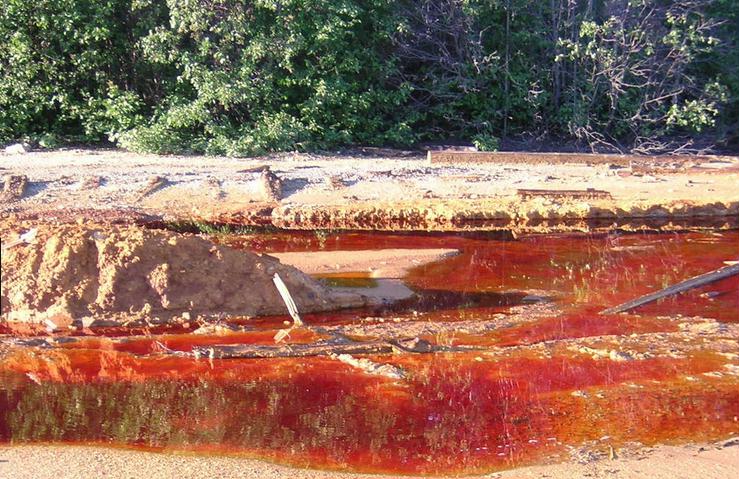Preface. This barely scratches the problems of mining wastes, but for what it’s worth, here are a few of the articles I’ve run across on this topic. Like burying nuclear waste deep underground while we still have cheap energy and social stability, cleaning up superfund and mining sites ought to be a top priority so that post fossil fuels, we leave future generations a better planet.
Alice Friedemann www.energyskeptic.com Women in ecology author of 2021 Life After Fossil Fuels: A Reality Check on Alternative Energy best price here; 2015 When Trucks Stop Running: Energy and the Future of Transportation”, Barriers to Making Algal Biofuels, & “Crunch! Whole Grain Artisan Chips and Crackers”. Podcasts: Crazy Town, Collapse Chronicles, Derrick Jensen, Practical Prepping, KunstlerCast 253, KunstlerCast278, Peak Prosperity
***
Service RF (2020) Red mud is piling up. Can scientists figure out what to do with it? Science.
Practical and glamorous, aluminum is prized for making products from kitchen foil and beverage cans to Tesla Roadsters and aircraft. But the silvery metal—abundant, cheap, lightweight, and corrosion resistant—has a dark side: red mud. This brownish red slurry, a caustic mishmash of metal- and silicon-rich oxides, often with a dash of radioactive and rare earth elements, is what’s left after aluminum is extracted from ore. And it is piling up. Globally, some 3 billion tons of red mud are now stored in massive waste ponds or dried mounds, making it one of the most abundant industrial wastes on the planet. Aluminum plants generate an additional 150 million tons each year.
Even when red mud remains contained, its extreme alkalinity can leach out, poison groundwater, and contaminate nearby rivers and ecosystems.
Workers extract the aluminum with a combination of treatments, including caustic chemicals, heat, and electricity. What remains is usually red, because of the iron, but its exact makeup can vary from region to region, depending on the ore, making it still harder to contend with. The composition of [red mud] varies so much it means one type of solution will not work.
Since 1964, he notes, researchers have patented some 700 uses for red mud, including tapping it to make decorative ceramics, dyes, and even fertilizer. Yet just 3% of red mud is currently recycled.
Hudson-Edwards K (2016) Tackling mine wastes. Science 352: 288-290
Excerpts:
Mine wastes are unwanted and uneconomic materials (including rock, sediment, tailings, metallurgical wastes, dusts, ash, and processing chemicals) that are found at or near mine sites in virtually every country in the world (2). They often contain elevated concentrations of elements such as antimony, arsenic, cadmium, copper, lead, uranium, and zinc. As a result, mine wastes can be toxic, corrosive, or radioactive, or a combination and harm the health of organisms, plants, and humans if ingested from water, soil, or food grown on the wastes, or inhaled as dust (3, 4).
Mine drainage waters are classified as acid, circumneutral, or basic depending on their pH (5). Both acidic and basic mine wastes are corrosive and contain potentially toxic or radioactive elements. Globally, acid mine wastes, which arise mainly from the oxidation of iron-sulfide minerals such as pyrite, are the most common. Solid mine wastes often also have a physical as well as chemical impact on the environment. For example, they may cause excessive sedimentation of river systems, altering their natural geomorphological evolution and potentially suffocating aquatic life. Winds can spread these wastes in the form of dust, particularly in arid areas.
Globally, most high-grade ores have already been exploited.
Contemporary mining therefore tends to focus on the extraction of lower-grade ores. As a result, current mining operations are associated with higher volumes of waste than previously produced.
Historical mine wastes have been accumulating since prehistory and can pose hazards that are potentially just as serious as those resulting from recent mining since methods were less efficient, environmental protection did not exist, and toxic elements such as mercury were used extensively (as they are in some artisanal mining areas today) to extract ores such as silver and gold (6).
There are many examples of historical and contemporary mine wastes posing threats to the environment. For example, in August 2015, waste water and tailings from the Gold Creek Mine flooded into Cement Creek and the Animas River in Colorado, USA, turning them bright yellow. The spill was caused by the attempted remediation of historical mine wastes (7).
The global footprint of historical and contemporary mine wastes is clearly substantial:
- 6% of English and Welsh rivers are affected by cadmium-, lead-, and zinc-contaminated discharges from historical mines and weathering of historical mining—contaminated sediments.
- In Bolivia, 35 km2 of the Pilcomayo floodplain is covered with heavy metal—contaminated sediments that have been discharged as mining waste over the past 500 years (11).
- Globally about 1 million km2 are covered with mine waste, amounting to several hundred thousand million tons of waste. Although this is a small percentage of Earth’s surface, much of it is in inhabited areas or areas of important biodiversity and natural beauty.
Overall the environmental impacts of mine wastes are negative. Around the globe, tailings dam accidents, physical weathering, and biogeochemical reactions lead to the remobilization of mine wastes from mine sites to the atmosphere, soils, water, and biosphere, posing risks to global ecosystem and human health.
We lack knowledge of many of these environmentally critical reactions. For example, we do not fully understand the biogeochemical behavior of many elements in mine wastes, including the elements bismuth, lithium, and tantalum, which are extensively mined today for use in modern technologies such as solar panels, batteries, and mobile phones. To predict future impacts, we also need to build knowledge of the influence of climate change on the rates of mine waste remobilization.
References

